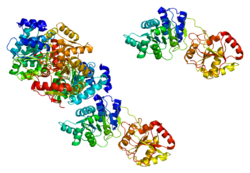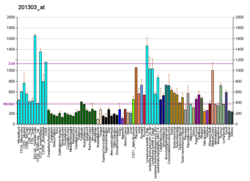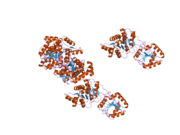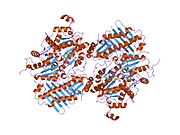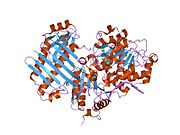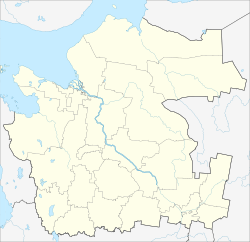EIF4A3
EIF4A3진핵생물 개시인자 4A-III는 EIF4A3 [5][6][7]유전자에 의해 인체 내에서 암호화되는 단백질이다.
기능.
이 유전자는 DEAD 박스 단백질 패밀리의 일원을 암호화합니다.보존 모티브 Asp-Glu-Ala-Asp(DEAD)를 특징으로 하는 DEAD 박스 단백질은 추정 RNA 헬리케이스이다.이들은 번역 개시, 핵 및 미토콘드리아 스플라이싱, 리보솜 및 스플라이세솜 조립과 같은 RNA 2차 구조의 변화를 포함하는 많은 세포 과정에 관여한다.그들의 분포 패턴에 근거하여, 이 과의 일부 구성원들은 배아 발생, 정자 형성, 그리고 세포 성장과 분열에 관여하는 것으로 여겨진다.이 유전자에 의해 암호화된 단백질은 핵 매트릭스 단백질이다.그 아미노산 배열은 DEAD 박스 단백질 [7]계열의 다른 두 구성원인 번역 개시 인자 eIF4A-I 및 eIF4A-II의 아미노산 배열과 매우 유사하다.
레퍼런스
- ^ a b c GRCh38: 앙상블 릴리즈 89: ENSG00000141543 - 앙상블, 2017년 5월
- ^ a b c GRCm38: 앙상블 릴리즈 89: ENSMUSG000025580 - 앙상블, 2017년 5월
- ^ "Human PubMed Reference:". National Center for Biotechnology Information, U.S. National Library of Medicine.
- ^ "Mouse PubMed Reference:". National Center for Biotechnology Information, U.S. National Library of Medicine.
- ^ Holzmann K, Gerner C, Poltl A, Schafer R, Obrist P, Ensinger C, Grimm R, Sauermann G (Feb 2000). "A human common nuclear matrix protein homologous to eukaryotic translation initiation factor 4A". Biochem Biophys Res Commun. 267 (1): 339–44. doi:10.1006/bbrc.1999.1973. PMID 10623621.
- ^ Chan CC, Dostie J, Diem MD, Feng W, Mann M, Rappsilber J, Dreyfuss G (Jan 2004). "eIF4A3 is a novel component of the exon junction complex". RNA. 10 (2): 200–9. doi:10.1261/rna.5230104. PMC 1370532. PMID 14730019.
- ^ a b "Entrez Gene: EIF4A3 eukaryotic translation initiation factor 4A, isoform 3".
추가 정보
- Nagase T, Miyajima N, Tanaka A, et al. (1995). "Prediction of the coding sequences of unidentified human genes. III. The coding sequences of 40 new genes (KIAA0081-KIAA0120) deduced by analysis of cDNA clones from human cell line KG-1". DNA Res. 2 (1): 37–43. doi:10.1093/dnares/2.1.37. PMID 7788527.
- Li Q, Imataka H, Morino S, et al. (1999). "Eukaryotic Translation Initiation Factor 4AIII (eIF4AIII) Is Functionally Distinct from eIF4AI and eIF4AII". Mol. Cell. Biol. 19 (11): 7336–46. doi:10.1128/mcb.19.11.7336. PMC 84727. PMID 10523622.
- Jurica MS, Licklider LJ, Gygi SR, et al. (2002). "Purification and characterization of native spliceosomes suitable for three-dimensional structural analysis". RNA. 8 (4): 426–39. doi:10.1017/S1355838202021088. PMC 1370266. PMID 11991638.
- Lee S, Baek M, Yang H, et al. (2002). "Identification of genes differentially expressed between gastric cancers and normal gastric mucosa with cDNA microarrays". Cancer Lett. 184 (2): 197–206. doi:10.1016/S0304-3835(02)00197-0. PMID 12127692.
- Strausberg RL, Feingold EA, Grouse LH, et al. (2003). "Generation and initial analysis of more than 15,000 full-length human and mouse cDNA sequences". Proc. Natl. Acad. Sci. U.S.A. 99 (26): 16899–903. Bibcode:2002PNAS...9916899M. doi:10.1073/pnas.242603899. PMC 139241. PMID 12477932.
- Palacios IM, Gatfield D, St Johnston D, Izaurralde E (2004). "An eIF4AIII-containing complex required for mRNA localization and nonsense-mediated mRNA decay". Nature. 427 (6976): 753–7. doi:10.1038/nature02351. PMID 14973490. S2CID 4400243.
- Ferraiuolo MA, Lee CS, Ler LW, et al. (2004). "A nuclear translation-like factor eIF4AIII is recruited to the mRNA during splicing and functions in nonsense-mediated decay". Proc. Natl. Acad. Sci. U.S.A. 101 (12): 4118–23. doi:10.1073/pnas.0400933101. PMC 384704. PMID 15024115.
- Shibuya T, Tange TØ, Sonenberg N, Moore MJ (2004). "eIF4AIII binds spliced mRNA in the exon junction complex and is essential for nonsense-mediated decay". Nat. Struct. Mol. Biol. 11 (4): 346–51. doi:10.1038/nsmb750. PMID 15034551. S2CID 30171314.
- Jin J, Smith FD, Stark C, et al. (2004). "Proteomic, functional, and domain-based analysis of in vivo 14-3-3 binding proteins involved in cytoskeletal regulation and cellular organization". Curr. Biol. 14 (16): 1436–50. doi:10.1016/j.cub.2004.07.051. PMID 15324660. S2CID 2371325.
- Gerhard DS, Wagner L, Feingold EA, et al. (2004). "The Status, Quality, and Expansion of the NIH Full-Length cDNA Project: The Mammalian Gene Collection (MGC)". Genome Res. 14 (10B): 2121–7. doi:10.1101/gr.2596504. PMC 528928. PMID 15489334.
- Andersen JS, Lam YW, Leung AK, et al. (2005). "Nucleolar proteome dynamics". Nature. 433 (7021): 77–83. doi:10.1038/nature03207. PMID 15635413. S2CID 4344740.
- Xia Q, Kong XT, Zhang GA, et al. (2005). "Proteomics-based identification of DEAD-box protein 48 as a novel autoantigen, a prospective serum marker for pancreatic cancer". Biochem. Biophys. Res. Commun. 330 (2): 526–32. doi:10.1016/j.bbrc.2005.02.181. PMID 15796914.
- Ballut L, Marchadier B, Baguet A, et al. (2005). "The exon junction core complex is locked onto RNA by inhibition of eIF4AIII ATPase activity". Nat. Struct. Mol. Biol. 12 (10): 861–9. doi:10.1038/nsmb990. PMID 16170325. S2CID 1359792.
- Rual JF, Venkatesan K, Hao T, et al. (2005). "Towards a proteome-scale map of the human protein-protein interaction network". Nature. 437 (7062): 1173–8. Bibcode:2005Natur.437.1173R. doi:10.1038/nature04209. PMID 16189514. S2CID 4427026.
- Gehring NH, Kunz JB, Neu-Yilik G, et al. (2005). "Exon-junction complex components specify distinct routes of nonsense-mediated mRNA decay with differential cofactor requirements". Mol. Cell. 20 (1): 65–75. doi:10.1016/j.molcel.2005.08.012. PMID 16209946.
- Andersen CB, Ballut L, Johansen JS, et al. (2006). "Structure of the exon junction core complex with a trapped DEAD-box ATPase bound to RNA". Science. 313 (5795): 1968–72. doi:10.1126/science.1131981. PMID 16931718. S2CID 26409491.
- You KT, Li LS, Kim NG, et al. (2007). "Selective Translational Repression of Truncated Proteins from Frameshift Mutation-Derived mRNAs in Tumors". PLOS Biol. 5 (5): e109. doi:10.1371/journal.pbio.0050109. PMC 1854916. PMID 17456004.
- Zhang Z, Krainer AR (2007). "Splicing remodels messenger ribonucleoprotein architecture via eIF4A3-dependent and -independent recruitment of exon junction complex components". Proc. Natl. Acad. Sci. U.S.A. 104 (28): 11574–9. doi:10.1073/pnas.0704946104. PMC 1913901. PMID 17606899.
